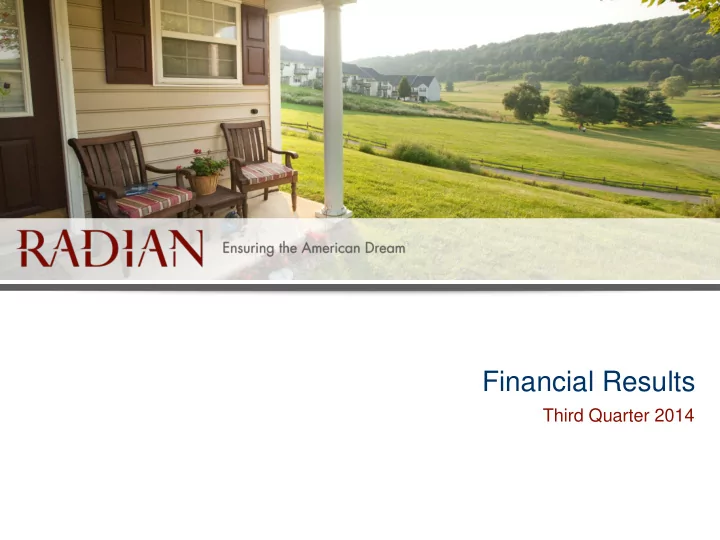

Financial Results Third Quarter 2014
Safe Harbor Statements All statements in this report that address events, developments or results that we expect or anticipate may occur in the future are “forward-looking statements” within the meaning of Section 27A of the Securities Act of 1933, Section 21E of the Exchange Act and the U.S. Private Securities Litigation Reform Act of 1995. In most cases, forward-looking statements may be identified by words such as “anticipate,” “may,” “will,” “could,” “should,” “would,” “expect,” “intend,” “plan,” “goal,” “contemplate,” “believe,” “estimate,” “predict,” “project,” “potential,” “continue,” “seek,” “strategy,” “future,” “likely” or the negative or other variations on these words and other similar expressions. These statements, which may include, without limitation, projections regarding our future performance and financial condition, are made on the basis of management’s current views and assumptions with respect to future events. Any forward-looking statement is not a guarantee of future performance and actual results could differ materially from those contained in the forward-looking statement. These statements speak only as of the date they were made, and we undertake no obligation to update or revise any forward-looking statements, whether as a result of new information, future events or otherwise. We operate in a changing environment. New risks emerge from time to time and it is not possible for us to predict all risks that may affect us. The forward-looking statements, as well as our prospects as a whole, are subject to risks and uncertainties that could cause actual results to differ materially from those set forth in the forward-looking statements including: changes in general economic and political conditions, including unemployment rates, changes in the U.S. housing and mortgage credit markets (including declines in • home prices and property values), the performance of the U.S. or global economies, the amount of liquidity in the capital or credit markets, changes or volatility in interest rates or consumer confidence and changes in credit spreads, all of which may be impacted by, among other things, legislative activity or inactivity (including legislative changes impacting the obligations of the public or sovereign entities that our financial guaranty business insures), actual or threatened downgrades of U.S. government credit ratings, or actual or threatened defaults on U.S. government obligations; changes in the way customers, investors, regulators or legislators perceive the strength of private mortgage insurers or financial guaranty providers, in particular in • light of the fact that certain of our former competitors have ceased writing new insurance business and have been placed under supervision or receivership by insurance regulators; catastrophic events, municipal and sovereign or sub-sovereign bankruptcy filings or other economic changes in geographic regions where our mortgage insurance • exposure is more concentrated or where we have financial guaranty exposure; our ability to maintain sufficient holding company liquidity to meet our short- and long-term liquidity needs; • a reduction in, or prolonged period of depressed levels of, home mortgage originations due to reduced liquidity in the lending market, tighter underwriting standards, • or general reduced housing demand in the U.S., which may be exacerbated by regulations impacting home mortgage originations, including requirements established under the Dodd-Frank Act; our ability to maintain an adequate risk-to-capital position, minimum policyholder position and other surplus requirements for Radian Guaranty, our principal • mortgage insurance subsidiary, and an adequate minimum policyholder position and surplus for our insurance subsidiaries that provide reinsurance or capital support to Radian Guaranty; Radian Guaranty’s ability to comply with the financial requirements of the PMIERs (once adopted) within the applicable transition period which, based on the • proposed PMIERs, may require us to contribute a substantial portion of our holding company cash and investments to Radian Guaranty, and could depend on our ability to, among other things: (1) successfully monetize Radian Asset Assurance, a direct subsidiary of Radian Guaranty, or otherwise utilize the capital at Radian Asset Assurance in a manner that complies with the PMIERs; and (2) obtain reinsurance for a portion of our mortgage insurance risk-in-force in a manner that is compliant with the PMIERs. The amount of capital or capital relief that may be required to comply with the PMIERs also may be impacted by the performance of our mortgage insurance business, including our level of defaults, the losses we incur on new and existing defaults and the amount and credit characteristics of new business we write, among other factors. Contributing a substantial portion of our holding company cash and investments to Radian Guaranty would leave Radian Group with less liquidity to satisfy its obligations, and we may not be successful in monetizing or otherwise utilizing the capital of Radian Asset Assurance or in obtaining qualifying reinsurance for our mortgage insurance risk-in-force on terms that are acceptable to us, if at all. In the event we are unable to successfully execute these or similar transactions or strategies, or such transactions are not available on terms that are acceptable to us, we may be required or we may decide to seek additional capital by incurring additional debt, by issuing additional equity, or by selling assets, which we may not be able to do on favorable terms, if at all. The ultimate form of the PMIERs and the timeframe for their implementation remain uncertain; 2
Recommend
More recommend